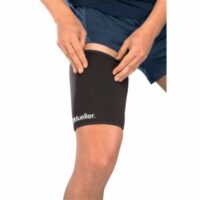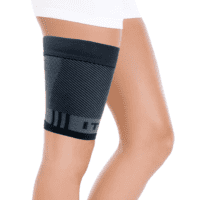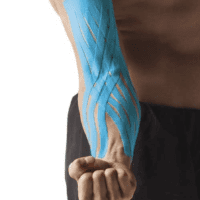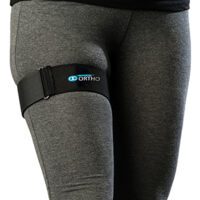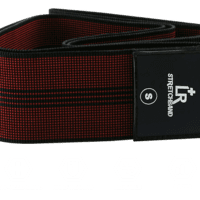Hamstring Strain
Article by John Miller


Hamstring Strain
A Comprehensive Guide from a Physiotherapist’s Perspective
Understanding Hamstring Strain
Hamstring strains, often encountered by athletes and active individuals, occur when the muscles at the back of the thigh stretch or tear beyond their capacity. This group, comprising the semimembranosus, semitendinosus, and biceps femoris, plays a key role in knee flexion and hip extension. Mild strains generally respond well to exercise-based rehabilitation, while severe cases might need surgical intervention.
The Crucial Diagnosis of Hamstring Injuries
Accurate diagnosis is paramount. It involves a physical examination focusing on symptoms like pain, tenderness, and swelling, along with assessing the range of motion and strength. Advanced imaging tests like X-rays, MRI, or ultrasound are crucial in determining the injury’s severity and affected areas.
Differentiating Hamstring Pain from Sciatica
Hamstring strain symptoms can mimic sciatica, presenting pain, weakness, or tingling in the legs. However, thorough physical examinations and imaging tests help differentiate them, underscoring the importance of seeking medical attention for accurate diagnosis and treatment.
The Root Causes of Hamstring Strain
Factors like improper running mechanics, inappropriate training loads, fatigue, lower back issues, and gluteal weakness can lead to hamstring strains. A history of such strains heightens the risk of future injuries. Muscular incoordination, lack of muscle stiffness, and reduced eccentric strength are often primary contributors.
Preventing Hamstring Injuries
Preventive measures include proper warm-up routines, active and dynamic exercises, and attention to training loads, form, and posture. This strengthens and maintains hamstring flexibility. Personalised advice from a physiotherapist, considering specific sports or activities, is advisable.


Effective Hamstring Treatments
Treatment strategies vary from RICE (Rest, Ice, Compression, and Elevation) to physiotherapy, and sometimes surgery, depending on the injury’s severity.
Recovery times differ – Grade I strains might need 1-3 weeks, Grade II strains could require 4-8 weeks, while Grade III strains, the most severe, might take 3-6 months.
The Role of Kinesio Taping in Recovery
Kinesio taping, a popular choice among patients, offers support, warmth, and proprioceptive feedback, reducing re-injury risks. This technique uses elastic tape to stabilise muscles and joints, enhancing movement and reducing pain.
Recent Research Insights
Recent studies highlight the effectiveness of eccentric strengthening exercises in hamstring rehabilitation. Incorporating these exercises can significantly reduce re-injury rates and improve recovery times. Research also emphasises the importance of individualised rehabilitation programs, tailored to each patient’s specific needs and athletic demands.
Conclusion and Professional Advice
For optimal management of hamstring strains, consulting a sports-focused physiotherapist or sports physician is crucial. They provide accurate diagnoses and devise rehabilitation techniques aimed at promoting healing and preventing further injury. Remember, each injury is unique, and professional guidance ensures a safer, quicker return to your active lifestyle.
Seek the advice of your physiotherapist for a tailored approach to hamstring strain prevention and rehabilitation.
Article by John Miller
Thigh Injuries
Thigh injuries can significantly impact your daily life and activities, whether you're an athlete or someone who enjoys staying active. As a physiotherapist, I often encounter individuals seeking assistance for various lower body ailments. In this guide, I'll discuss the most common thigh injuries, their causes, prevention strategies, and when to seek professional advice.


Common Thigh Injuries
- Thigh injuries encompass a range of conditions, including muscle strains and contusions. These injuries often occur during sports activities, sudden movements, or accidents. Symptoms may include pain, swelling, bruising, and difficulty moving the affected leg.
- A hamstring strain involves damage to one or more of the muscles at the back of the thigh. This injury is prevalent among athletes, particularly those involved in sports requiring sprinting, jumping, or sudden changes in direction. Symptoms include sharp pain, tenderness, and weakness in the hamstring muscles.
- Iliotibial band syndrome, or ITB syndrome, is a common overuse injury among runners and cyclists. It occurs when the ITB, a thick band of tissue running along the outside of the thigh, becomes inflamed or irritated. Symptoms typically include pain on the outer side of the knee, especially during activities such as running or cycling.
- Runner's knee, also known as patellofemoral pain syndrome, is a common complaint among runners, cyclists, and individuals who engage in repetitive knee movements. It causes pain around or behind the kneecap, often exacerbated by activities such as climbing stairs, squatting, or sitting for prolonged periods.
- Sciatica refers to pain that radiates along the path of the sciatic nerve, which runs from the lower back through the hips and down each leg. It can result from various factors, including a herniated disc, spinal stenosis, or muscle tightness. Symptoms may include sharp or burning pain, numbness, tingling, and weakness in the legs.
Prevention Strategies
Preventing lower body injuries begins with understanding the risk factors and implementing proactive measures. Here are some strategies to help you safeguard your lower body health:
- Warm-up and Cool-down: Incorporate dynamic warm-up exercises before physical activity to prepare your muscles and joints for movement. Follow up with gentle stretching and cool-down exercises to aid in muscle recovery and flexibility.
- Gradual Progression: Avoid overexertion by gradually increasing the intensity, duration, and frequency of your workouts. Sudden spikes in activity level can increase the risk of injury, so listen to your body and progress at a pace that feels comfortable.
- Proper Technique: Ensure proper form and technique during exercise to minimise the risk of strain or injury. Consult with a qualified fitness instructor or physiotherapist to learn correct movement patterns and modifications tailored to your needs.
- Strength and Flexibility: Incorporate strength and flexibility exercises targeting the muscles surrounding your thighs, hips, and knees. Focus on exercises that improve stability, balance, and range of motion to support your lower body joints during physical activity.
- Rest and Recovery: Allow for adequate rest and recovery between workouts to prevent overuse injuries and promote muscle repair. Listen to your body's cues and avoid pushing through pain or fatigue, as this can lead to further injury.
Conclusion
By prioritising prevention strategies and seeking professional guidance when needed, you can minimise the risk of experiencing debilitating lower body injuries. Remember to listen to your body, respect its limits, and invest in its long-term health and functionality.
What to Do?
If you're experiencing persistent pain or discomfort in your lower body, it's essential to seek the guidance of a qualified physiotherapist. They can assess your condition, provide targeted treatment, and develop a tailored rehabilitation plan to help you recover safely and effectively.
Related Articles
- Understanding and Treating Thigh Injuries
- Preventing Hamstring Strains: Tips and Exercises
- Managing ITB Syndrome: Effective Treatment Strategies
- Runner’s Knee: Causes, Symptoms, and Treatment
- Sciatica Relief: Exercises and Therapies
- Lower Body Strengthening Exercises for Injury Prevention
- The Importance of Warm-up and Cool-down for Athletes
- Understanding Overuse Injuries in Sports
- Effective Strategies for Rest and Recovery
- When to Seek Physiotherapy for Sports Injuries







































